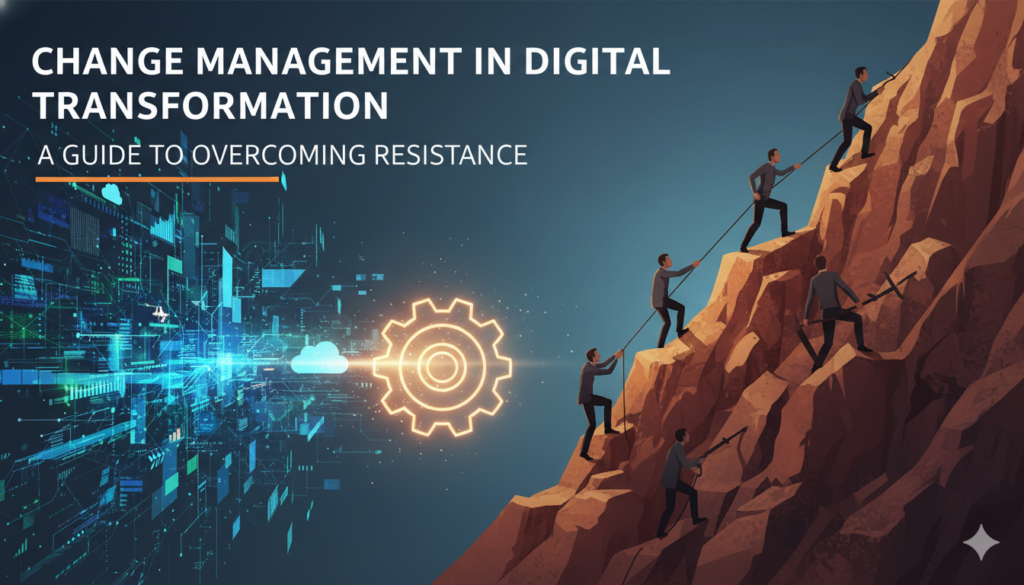Most businesses don’t lack data – they lack direction. Teams spend hours building dashboards, reviewing metrics, and tracking KPIs, yet still miss the mark when it comes to making confident, insight-led decisions. Why? Because the real challenge isn’t data collection – it’s action.
To become a truly data-driven enterprise, organizations must go beyond passive reporting. It’s about creating systems where insights actively shape product roadmaps, campaign strategies, and operational priorities. It’s about empowering teams to ask better questions – and actually act on the answers.
In this blog, we’ll break down what it takes to operationalize analytics: from designing the right data foundations to embedding insights into every department’s workflow. Whether you’re scaling your data maturity or trying to move from gut feel to grounded decisions, this guide is your blueprint to turning analytics into outcomes.
What It Really Means to Be a Data-Driven Enterprise
Being “data-driven” has become a default goal for modern businesses – but the reality behind the term is often misunderstood. It’s not just about collecting metrics or building dashboards. A data-driven enterprise uses data to inform, validate, and accelerate decisions at every level – from leadership strategy to frontline execution.
Here’s what that looks like in practice:
- Decisions start with questions, not assumptions. Instead of relying on gut feel or legacy intuition, teams use data to frame hypotheses, test ideas, and course-correct in real time.
- Insights are embedded into workflows. Data isn’t confined to a BI tool. It’s integrated into CRMs, product analytics, marketing platforms, and ops systems – so teams act on it where they work.
- Everyone understands the ‘why’ behind the data. It’s not just analysts reading the numbers. Product managers, marketers, sales leads, and even customer support teams are data-literate and aligned on what success looks like.
- Culture supports experimentation. A data-driven culture treats every campaign, release, or ops change as an opportunity to learn and optimize – not just to launch and forget.
Companies like Amazon and Netflix didn’t become leaders by accident. They institutionalized a culture where data is the foundation – not the byproduct – of growth and innovation. But this level of maturity isn’t exclusive to tech giants. With the right mindset, structure, and tools, any business can evolve into a data-driven enterprise – no matter the size or industry.
Why Most Organizations Struggle to Extract Actionable Insights
Collecting data isn’t the hard part anymore. Most businesses are already tracking dozens of metrics across tools like CRMs, ERPs, product analytics, and ad platforms. The problem? Too much of that data sits idle, disconnected, or misunderstood.
Here’s where things usually break down:
1. Siloed Systems and Fragmented Ownership
Different departments use different tools – and often don’t speak the same data language. Marketing might measure campaign success by impressions, while sales focuses on SQLs and finance is tracking CAC. Without a unified view or shared KPIs, insights stay trapped in silos, making cross-functional decision-making difficult.
2. Low Data Literacy Across Teams
You can’t act on what you don’t understand. If teams aren’t trained to interpret data – or if insights aren’t communicated in context – then even the most advanced dashboards won’t drive meaningful decisions. Worse, teams may cherry-pick metrics that support existing narratives, leading to biased outcomes.
3. Analysis Without Context
Plenty of businesses report on the what (“signups dropped 20% last month”) but struggle with the why and what next. Without connecting insights to business goals, customer behavior, or operational changes, data becomes a mirror, not a map.
4. Misaligned Metrics
Many teams obsess over metrics that look impressive but don’t move the needle – vanity KPIs like pageviews, open rates, or social reach. Being data-driven doesn’t mean chasing every data point – it means focusing on the few that matter to growth, efficiency, or customer impact.
The bottom line: It’s not a lack of tools or reports that holds teams back – it’s the lack of clarity, ownership, and strategic alignment. Without a system to translate analysis into action, data becomes just another dashboard no one logs into.
Turning Raw Data into Action – The 4-Step Framework
Transforming data into business outcomes doesn’t happen by chance. It requires a deliberate framework that connects raw numbers to decisions, and decisions to execution. Here’s a four-step process to help teams consistently move from analysis to action:
Step 1: Capture the Right Data (Not All the Data)
Start with the decisions you want to improve – then work backward. What insights do your teams need to ship faster, optimize spend, reduce churn, or drive growth? Once those questions are clear, focus on collecting structured, high-quality data that supports them.
Pro tip: More data isn’t always better. Start lean with relevant sources – CRM activity, product usage, campaign performance – then scale as needed.
Step 2: Analyze with Business Context
Data without context is just noise. Use the right tools (SQL, Looker, Tableau, Power BI, Python notebooks, etc.) to explore trends – but always frame the analysis around business objectives. Don’t just look at the what; investigate the why.
- Ask: “What’s driving this change?”
- Compare against benchmarks
- Collaborate with functional stakeholders for frontline context
Step 3: Extract Insights That Are Actually Actionable
A good insight is simple, timely, and specific. It should clearly inform a decision or trigger a response. Avoid vague conclusions like “engagement dropped” – instead, dig deeper to say, “Feature X saw a 40% decline in usage after the UI change in v2.1.”
Focus on:
- What happened?
- Why did it happen?
- What should we do about it?
- Who needs to act?
Step 4: Operationalize the Insights
This is where most orgs fall short. Insights need to be embedded into systems, rituals, and workflows – not just shared in a Slack message or a weekly slide.
- Sync product insights with sprint planning
- Feed campaign data into GTM strategy
- Connect customer churn patterns to support or onboarding flows
- Automate triggers (e.g., alerts for funnel drop-offs)
Create an “insight-to-action” loop: measure → act → validate → refine.
Done right, this cycle becomes part of your operating system.
Turning Insights Into Action: Use Cases by Department
When analytics stays confined to a data team, its impact is limited. The real value emerges when insights power decisions across the business – from growth strategy to product development and customer experience.
Here’s how different departments can leverage data more effectively:
Marketing
- Insight: Ad spend is highest on Campaign A, but Campaign B is generating 3x more qualified leads.
- Action: Reallocate budget toward Campaign B and pause low-performing ad sets.
- Tools: Google Analytics 4, HubSpot, attribution platforms (e.g., Triple Whale)
Other examples:
- A/B test landing pages based on conversion heatmaps
- Optimize SEO strategy based on keyword ranking shifts
Sales
- Insight: Demo-to-close rate is lowest for leads from a specific channel or industry segment.
- Action: Refine ICP, adjust lead routing, or update messaging for that segment.
- Tools: Salesforce, Gong, Outreach, ZoomInfo
Other examples:
- Use predictive scoring to prioritize high-intent accounts
- Align sales plays based on customer behavior data
Product
- Insight: Feature X has low adoption despite high initial interest during onboarding.
- Action: Improve UX, reintroduce feature in onboarding, or test placement changes.
- Tools: Mixpanel, Amplitude, Hotjar, FullStory
Other examples:
- Track usage trends across cohorts to inform the roadmap
- Identify friction points in feature usage to reduce churn
Operations
- Insight: Customer ticket volume spikes after every major release.
- Action: Tighten QA cycles, expand release notes, and improve internal training.
- Tools: Zendesk, Jira, Freshservice, custom dashboards
Other examples:
- Analyze resource utilization to improve staffing efficiency
- Forecast demand fluctuations to reduce downtime or overstocking
Across every function, the formula is the same: use data to find patterns, translate those into clear decisions, and close the loop with execution.
Building the Right Culture + Stack for Scalable Analytics
You can have the most advanced data tools in place, but without the right culture and systems to support them, insights won’t lead to action. Becoming a data-driven enterprise requires just as much investment in people and mindset as it does in platforms.
Build a Culture Where Data Drives Decisions
A scalable analytics function starts with people – not dashboards. Here’s how leading organizations cultivate data-first teams:
- Democratize access: Give every team access to the insights they need – without gatekeeping or overreliance on analysts.
- Upskill cross-functional teams: Basic data literacy should be expected across product, marketing, sales, and support – not just engineering.
- Reward curiosity, not just output: Encourage teams to question assumptions, run experiments, and learn from failures.
- Make data part of daily workflows: Don’t save insights for monthly reviews. Integrate them into sprint planning, GTM syncs, and leadership check-ins.
Choose the Right Stack for Your Stage
There’s no one-size-fits-all tech stack. Here’s how to approach it based on your growth stage:
Early Stage / Startups
- Focus: Fast experimentation, MVP-level reporting
- Stack: Google Analytics 4, Google Sheets, Looker Studio
Mid-Market
- Focus: Funnel optimization, deeper segmentation, cross-channel insights
- Stack: Snowflake or BigQuery, dbt, Looker or Power BI, HubSpot, Amplitude
Enterprise
- Focus: Data governance, scale, AI-driven insights, centralized control
- Stack: Databricks or Snowflake, Airbyte/Fivetran, dbt, Tableau, Looker, internal data lake integrations, Segment, custom-built models
Don’t over-engineer your stack. Choose tools your teams will actually use – and revisit them as your needs evolve.
Culture, stack, and adoption must work together. That’s what turns insights from static reports into strategic advantage.
Common Pitfalls and How to Avoid Them
Even with the right intentions, many organizations stall on their journey to becoming truly data-driven. The reasons usually aren’t technical – they’re operational, cultural, or strategic. Here are some of the most common mistakes, and how to avoid them:
Mistaking Tools for Strategy
Adopting a new BI tool doesn’t make you data-driven. It’s not about the platform – it’s about how insights are used to guide decisions and execution.
Fix: Anchor tool adoption in business use cases. Train teams on how to apply insights, not just navigate dashboards.
Overcomplicating Dashboards
Just because you can track everything doesn’t mean you should. Bloated dashboards create noise, not clarity.
Fix: Focus on 3–5 core metrics per team or function. Keep them tied to actual KPIs and outcomes.
No Feedback Loop
Data is gathered, reports are sent, but no one asks: “Did we act on this? Did it work?” Without iteration, insights become passive.
Fix: Set up a regular cadence – monthly or quarterly – to review which insights drove action and what results followed.
Misreading Correlation as Causation
Just because two things move together doesn’t mean one causes the other. Drawing the wrong conclusions leads to wasted time, budget, and trust.
Fix: Validate hypotheses with experiments, qualitative input, or historical benchmarks before acting.
Top-Down Only Analytics
When data is treated as an exec-only function, adoption suffers. Teams feel disconnected from the insights and less accountable for results.
Fix: Empower teams at every level with relevant data – and let them ask their own questions.
From Data-Driven to Results-Driven
Being data-driven isn’t about collecting more data – it’s about acting on the right insights at the right time. It means equipping every team with the tools, context, and confidence to make smarter decisions, faster.
By building the right culture, choosing tools that align with your stage, and creating tight feedback loops between data and execution, your organization can go beyond static reports and start using analytics as a true growth engine.
Ready to make your data work for you?
At Qatalys, we help organizations build modern data architectures and unlock real business impact through analytics. From strategy and integration to dashboard design and AI-powered insights – we make data work for your business.
Ready to transform your data into decisions? Talk to us.








